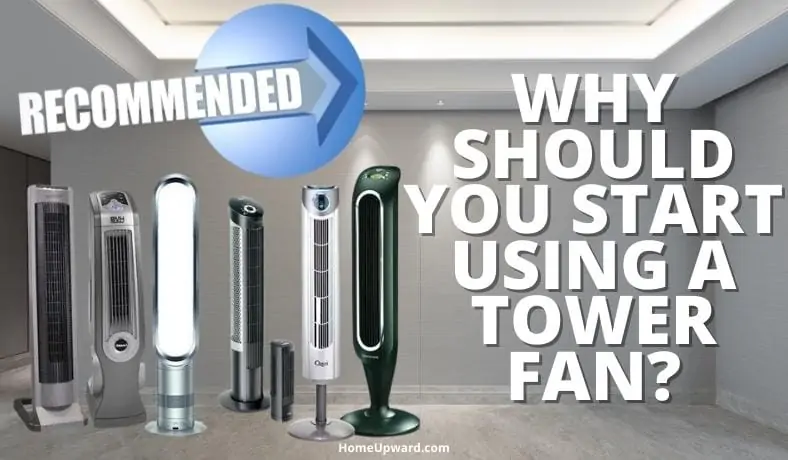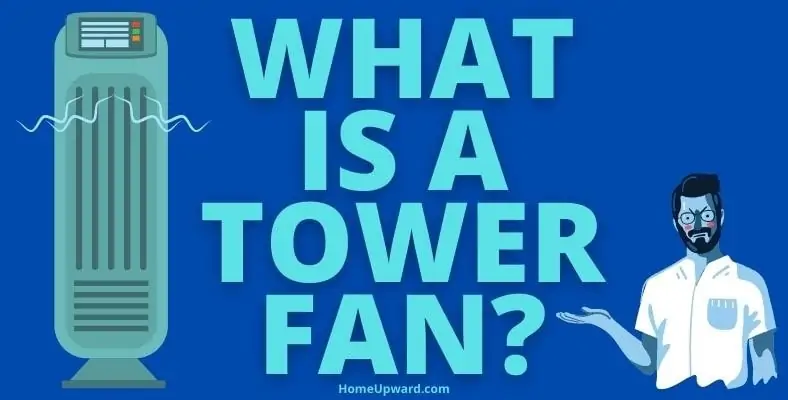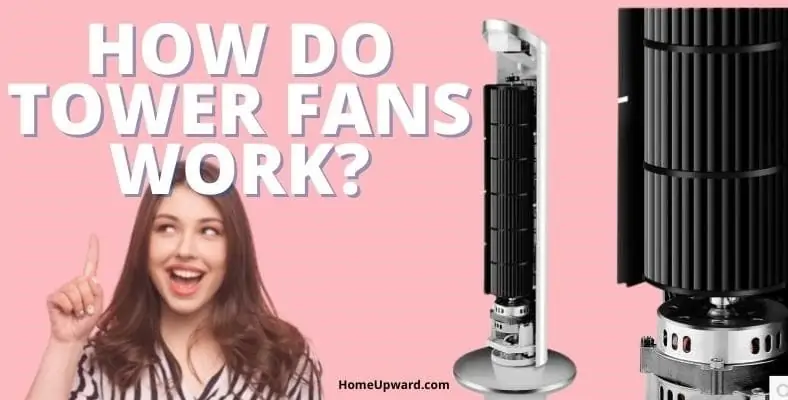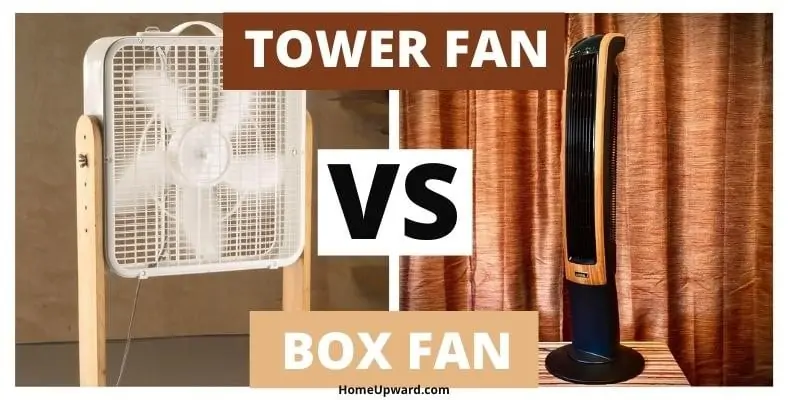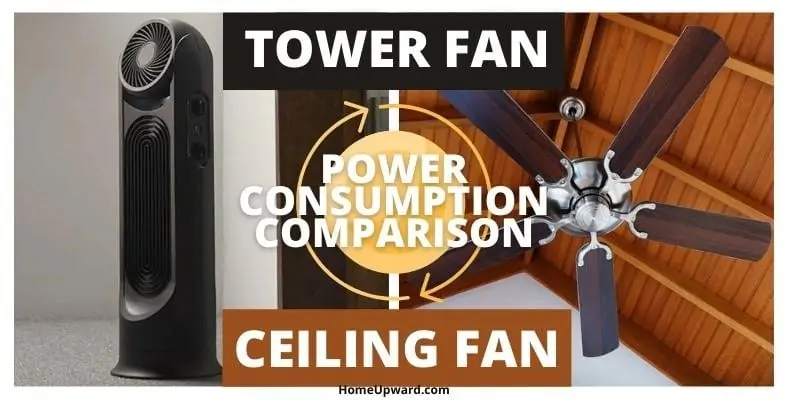If you don’t have a ceiling fan in place a standalone fan can be a cheap and rewarding way to get relaxed or add some ambient white noise. Besides their space-saving design, the advantages of tower fans don’t usually get the credit they deserve.
Let’s dig into why using a tower fan is good, what their benefits are, and how they stack up to comparable portable fans.
Contents
What is a tower fan?
Let’s start with the basics: what makes a fan a tower fan different?
They’re given their name because of their vertical (tall) design and how they look like a tower. They usually have inlets on each side (or the rear) to pull in air and vents on the front to blow out that air at a 90-degree angle to the floor. This is different from box fans, for example, that use a horizontally placed fan that just blows in one direction normally.
There’s a base at the bottom that helps keep them stable and in place to avoid tipping over. Most offer a feature in which the central part of the fan moves back and forth, also known as oscillating. They’re often known for their lightweight design and they’re easy to move around, too.
A grill designed into the chassis covers the vertically oriented fan blades to avoid fingers being able to touch them. Unlike other types, tower fans offer quieter operation and in many cases more fan speeds.
How do tower fans work?
Tower fans work by pulling air in the room and pushing it out forcefully to blow across your body and the room, much like how an old windmill or turbine works.
An electrically powered motor turns a cylinder-shaped fan assembly mounted on a shaft. This fan assembly has vertically oriented blades with a slight curve. Instead of being pushed horizontally like most fans, the air is forced through a tower fan vertically, creating a wider spread of the airflow.
A combination of the full-body output vents plus angled vents means air is feels a bit like a cool breeze. The electric motor also drives a gear that makes oscillation possible (I’ll cover this below in more detail), if the feature is built-in as it is for many models you can buy.
Do tower fans work for cooling?
Yes, tower fans work for cooling using a process called “forced convection” to remove the heat from your room and your body.
By moving the air fast through the room – and across your body – a tower fan removes surrounding heat, which results in you feeling cooler. Convection is the process of using liquids or gases (like air) to transfer heat.
As the fan’s air passes across your body, heat is removed and you feel cooler. (This is different from how an air conditioner works, of course, as those use a pressurized refrigerant cooling system to actually remove heat from the air.)
They’re very good for keeping energy use costs down, by the way! I’ll give you some specific examples as we go.
What does “oscillating fan” mean?
Oscillation is used to describe something that moves back and forth or side to side in a steady motion. An oscillating fan moves side to side, changing how the air flows and covering much more area in a room than a traditional fixed fan.
The fan’s cooling airflow is spread more evenly throughout the room and creates a more comfortable environment. To be classified as an oscillating fan, the fan must have a base or body fixed in a place and a fan head that moves from side to side.
Tower fan benefits and disadvantages
The benefits of tower fans
- Some tower fans come with a built-in sleep or auto-off timer. These work by shutting off the fan after a preset amount of time you can select.
- Some offer a built-in ionizer for air quality. An ionizer cleans the air clean by generating electrically charged ions (not to be confused with ozone) for removing dust, pollen, animal dander, and other things that can cause allergies. While not anywhere close to the effectiveness of a true air purifier it’s a nice added bonus.
- Air comfort features: some may offer a HEPA filter, misting mode, humidifier, and more! Some may also have a nightlight.
- Most are very light in weight (under 10 pounds).
- Affordability: they’re available in cheap basic models that still oscillate and move air up to expensive models with many more features.
- They’re attractive in design and many have a sleek appearance.
- Minimal floor space used: because of their tall design they don’t take up much usable space in a room.
- Some models offer an optional included remote control.
- Safety: they’re designed to prevent touching the spinning fan blades and some shut off automatically when tipped over.
Features to look for
Some of the best features I recommend you look for are:
- Remote control
- Multiple fan speeds
- Optional oscillation
- An auto-off timer
- LED or other digital display
- Safety features such as tipping and overheating protection
- An ultra-quiet sleep or low-noise mode
- High-speed turbo fan mode
- Filter change indicator light (where applicable)
- Moving handle or inset hand area for easier moving
- Air cleaning and purifying options, such as ionizer or a High Efficiency Particulate Air (HEPA) filter
Disadvantages of tower fans
- They have is lower airflow than a high-speed pedestal or box fan. Because of their design style and low-noise operation, the airflow isn’t quite as forceful as what you’d get from a good box fan for example.
- For people who love white noise to sleep or concentrate, they may not be a great choice as well if that’s important to you.
- While they do offer oscillation, most of them don’t have a tilt adjustment. That means you can’t point them up or down to change up the airflow.
How often should you clean your tower fan?
If you’re using your fan regularly then you’ll definitely want to check it and clean it every month if there’s a build-up of dust or dirt. For models with a filter, change the filters every three months or per the manufacturer’s recommendation. Note that you won’t always need to replace or clean it but at least checking it is definitely recommended.
Before you begin, make sure your fan isn’t plugged in. Cleaning the fan will likely release a lot of dust or allergens into the air so I recommend you take it outside where it won’t get everywhere (including your clothes) – especially back into the air you breathe. Using a vacuum cleaner is a great way to remove built-up dust and help keep it under control.
What you need to clean one
Items you may need to clean your tower fan include:
- Cleaning brush or cloth
- Compressed air
- Screwdriver (in some cases, depending on the particular model)
- Vacuum cleaner (optional) for removing built-up dust
Some will have a back or side panel you’ll need to unscrew. If there’s a removable filter, pull it out and clean it as needed or replace it. Use your compressed air and a cloth to carefully clean off the exterior outputs, fan blades, and anything you can see.
Try to remove as much built-up dirt and dust as possible. When you’re finished, replace the filter (if needed) and screw the panel back on.
Tower fan vs. pedestal fan differences
A pedestal fan is also known as a floor fan but with a pedestal body, meaning a vertical pole and a wide base at the bottom to help it stand. These are some of the most common types of fans – they are designed to be placed on the floor.
Most have a wide round base or horizontal “legs” that keep the bottom stable, along with 3 to 5 fan blades that spin and blow air horizontally. Most also offer an oscillation function and several selectable speeds: usually 3 or more speeds.
Pedestal vs. tower
- Space: When it comes to space used, a tower fan wins here. Tower fans are tall and slender – they can fit in tight spaces, small corners, or be tucked away discreetly while not in use. Pedestal fans aren’t bad exactly but do require a bit more space.
- Coverage area: A tower fan will win out over a pedestal fan every time. They cover a higher cubic foot per minute (CFM) airflow rate than pedestal fans.
- Purpose: When it comes to pure air output, a pedestal fan will often beat out a tower fan in this category. Tower fans can’t compete with the pure power of a pedestal fan. However, tower fans over more features overall than pedestal fans especially for quiet operation during nighttime.
- Style: Pedestal fans are often big, with few style options. Tower fans come in various colors, designs, and styles – some don’t even have blades!
- Noise level: pedestal fans produce more noise than tower fans. If white noise is very important to you this can be an advantage. Otherwise, tower fans are better for people who prefer quieter operation.
Box fans vs. tower fans
A box fan has a name that describes exactly how it looks – like a box. Sometimes called a tabletop fan, box fans are simple fans that have an outer box with some cage or screen with internal blades and a rotary speed control.
These fans are typically very square in appearance, but some may be rectangular or circular. They often sit very close to the ground as they sit directly on the floor or surface.
Tower vs. Box Fans
- Space: Box fans have many sizes, from tiny desktop fans to large, industrial fans, meaning they take up a bit more floor space than tower fans.
- Coverage area: If you need to cover a larger area a box fan isn’t for you. Since they only push air in one direction, they’re best suited for small spaces or areas where direct cooling is the best option.
- Purpose: A box fan pushes air straight forward. It blows directly where you point it, whereas a tower fan can turn 180 degrees with multi-directional airflow. Additionally, they don’t have a lot of other features like tower fans do. Their main bonus is the price point – box fans are often very cheap.
- Style: Box fans are available in various colors and sizes, just like their tower fan competitor. However, tower fans are more modern looking and more attractive especially for decorated home interiors.
- White noise: box fans have a big advantage here – they’re great for white noise to mask outside sounds or help you sleep. In that regards they may be more helpful for you than a tower fan which is more quiet.
- Energy use: while box fans don’t use a great deal of power, tower fans offer more energy-efficient modes and can help keep electricity use costs down even more.
Tower fan vs. ceiling fan power consumption
Ceiling fans, while not energy hogs, do use a bit more electrical power (watts) than tower fans. Here’s a comparison of some average models that will help illustrate what I mean.
Ceiling fan VS tower fan power comparison table
| Speed | Ceiling fan | Tower fan |
|---|---|---|
| Off | 0W | 0W |
| Low | 12W | 17W |
| Med. | 42W | 24W |
| High | 46.6W | 25.6W |
As you can see, a typical ceiling fan will use somewhere around 12 watts to under 50 watts. An average tower fan, however, will use a bit less (about 17 or so to about 26 watts on high speed). In other words, a typical tower fan will use about 1/2 the power at higher speeds than a ceiling fan.
On average, running a mid-sized tower fan 24 hours a day, 7 days a week for a year would cost you about $.339 a day or $120.05 a year. (This is based on the average price of electricity in the US at $13.17.) A high-velocity tower fan frequently would use more power, whereas a low-watt tower fan will use less energy and, therefore, less power and cost less.
One advantage to using a ceiling fan is that they have a large coverage area compared to floor, table, and box fans. The drawback is that they can’t be pointed directly at (or close to) any particular place in the room.

